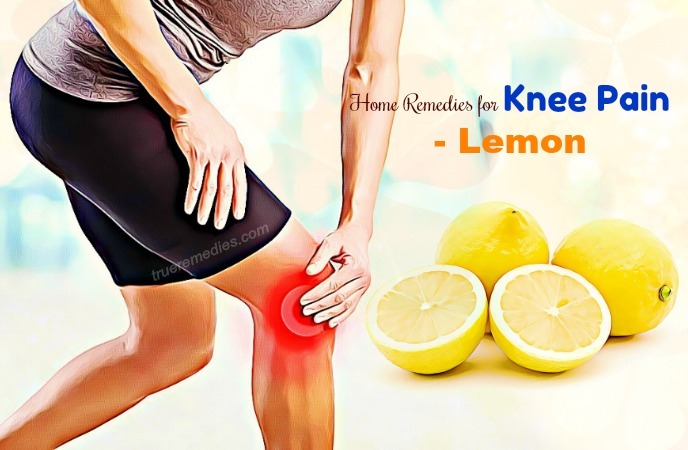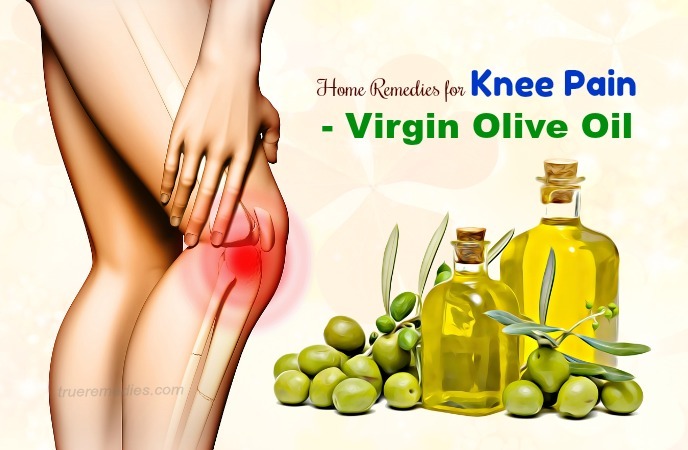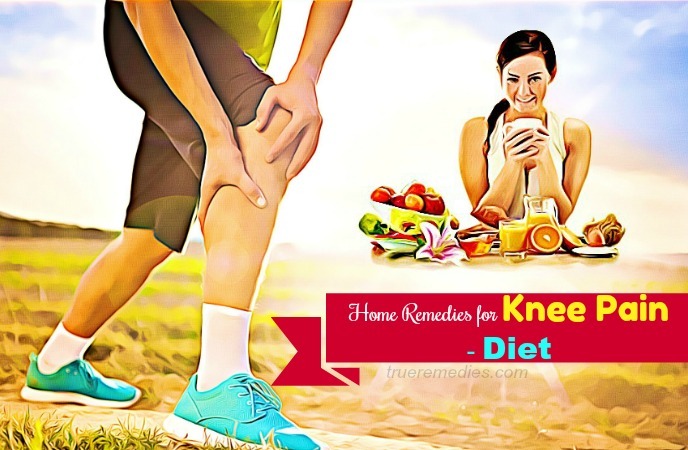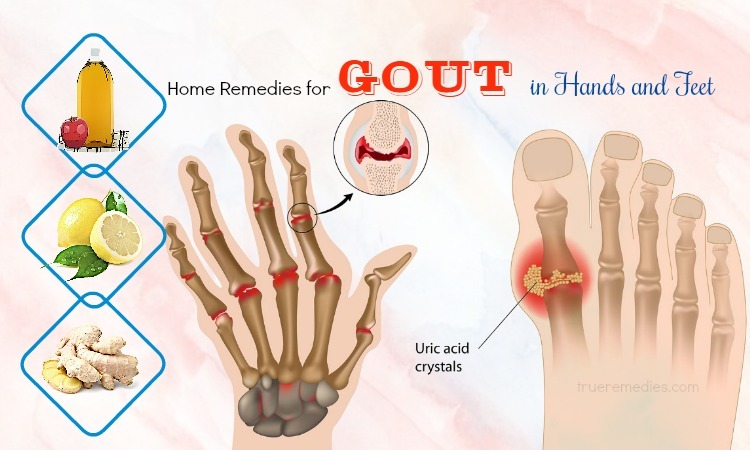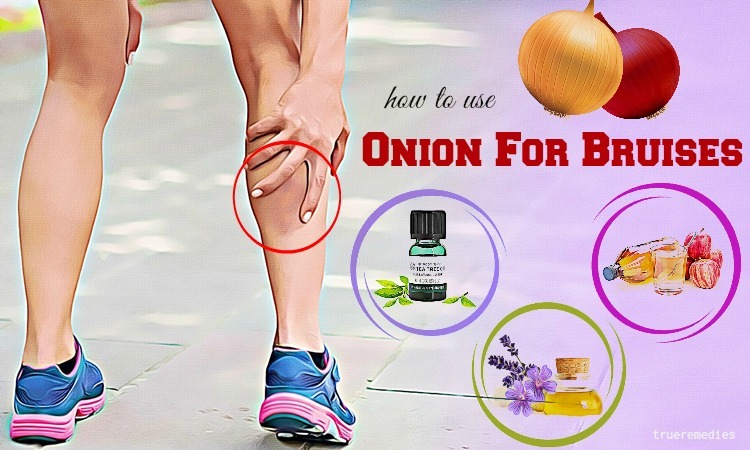updated: 11/20/2019
CONTENTS
Knee pain is a sign that the person is at risk of many other serious illnesses. If the condition is long and not treated promptly, the person with a knee problem is at risk for lifelong disability. However, many young people still do not have a lot of knowledge about knee pain, so they are still underestimated. They think that this disease is only present in the elderly. But in fact, knee pain is becoming increasingly rejuvenated, especially those who are less active and less active in physical exercise and sports.
Knee pain can be aggravated by exercise, affected by the surrounding muscles and their movements, and be triggered by other problems (such as a foot injury). Knee pain can affect people of all ages, and natural home remedies can be helpful unless it becomes severe. Keep reading this post to find out the best natural home remedies for knee pain relief.
- Natural home remedies for joint pain in old age
- Home remedies for leg pain during pregnancy
- Home remedies for foot pain and swelling relief
What Is Knee Pain?
Knee pain is pain around or in the knee. Most of the people experience knee pain at sometimes in their lives. Sports, exercise or other activities can cause muscle strains, tendinitis, and more serious injuries to ligaments and cartilage.
Knee pain can be localized to a specific area of the knee or be diffused throughout the knee. Knee pain includes:
- Osteoarthritis: Pain, inflammation, and joint destruction caused by degeneration and deterioration of the joint.
- Tendinitis: When climbing or going upstairs, this pain will be very clear. It will get worse if you continue with these activities without remedy.
- Bursitis: Inflammation caused by repeated overuse or injury of the knee.
- Chondromalacia Patella: Damaged cartilage under the kneecap.
The knee joint has an articulation between four bones namely the tibia, fibula, femur, and patella. Knee joints are a tight-knit bundle between the femur and tibia with anterior knee ligament and cross ligaments. Thanks to this solid combination, we can do more energetic and decisive moves such as running, jogging, and playing sports. People who have strong activity often suffer from knee injuries, which is primarily a frontal ligament injury. Any of these injuries can result in severe knee pain and could require surgeries.
TrueRemedies Partner Solutions

Need a Help from the Leading Expert Online, Available 24/7?
They’re all here and ready to answer your questions online or by phone. Keep asking questions until you get the answer you need.
Other injuries, including tears, can take place in the cartilage of the knee. Cartilage is a semi-hard (tough, but flexible) tissue that covers the end of your bones. A tear in the knee cartilage is a common injury and could require surgery.
Arthritis is a common cause of severe knee pain and disability. Unfortunately, arthritis is a chronic degenerative condition that can eventually require surgery. In this case, you may experience stiffness and swelling, and it may be hard to bend your knee.
What Are Common Causes Of Knee Pain?
There are many causes of knee pain. Physical conditions or diseases can cause knee pain. Let’s learn the common causes of knee pain:
- Injuries
The light to severe injuries below can be the cause of your knee pain:
- Tearing Ligaments And Tendons
You may have severe knee pain due to injuries. Injuries in sports, while working or traumatic injuries can result in tears in the ligaments and tendons. Ligaments have the effect of bones in the joints, muscles that connect the bones to the muscles. If you have torn ligaments and tendons outside your knees, you may have pain even when you are resting. Pain can be worse when you are walking because you put more weight on your injured knee.
- Bleeding
Injury can cause damage to the bones and other structures in your knee (such as joints), which can cause bleeding into the joints.
- Fracture
When your kneecap or other bones on your knees break, it can lead to severe knee pain. Sometimes, some small bones may damage joints or soft tissues in the knee.
- Arthritis
Arthritis in the knee includes diseases such as rheumatoid arthritis, osteoarthritis, lupus, and gout:
- Rheumatoid Arthritis
Rheumatoid arthritis damages joints and tissues in the knee, mainly causing inflammation. This is an autoimmune disease, which means that the body attacks its own tissues even though the tissues are completely normal.
- Osteoarthritis
This is a degenerative condition in the knee joint. Cartilage is a tissue made up of collagen. It lies between the bones in the knees and absorbs the force that is applied to the knees. Over time, cartilage can be destroyed so the buffering capacity will be reduced. Due to the loss of cartilage, the bones will rub together, causing pain, stiffness, and swelling in the knee joint. Broken bones can appear in the injured joints.
- Lupus
Like rheumatoid arthritis, lupus is an autoimmune disease. Lupus occurs when your immune system attacks healthy tissues in your body. Lupus affects not only the knees but also other organs such as the skin, brain, kidneys, or other parts of the body.
- Gout
Gout is a disease caused by metabolic disorders in the body. When uric acid builds up in the blood, it condenses in the form of crystals in the joint and causes arthritis. The first inflammation may appear in the knee joint, which can then spread through other joints.
- Osgood-Schlatter Disease
The disease is caused by a knee injury before it is fully developed. Symptoms usually include pain, swelling, and discomfort in the knee. The risk of illness increases if you play sports such as football, volleyball, and basketball.
- Infection
- Bone Infection
The common type of bone infection is bone marrow inflammation. Osteomyelitis can be caused by bacteria or fungi. You may feel pain in your knees and elsewhere, or fever and chills.
- Joint Infections
Rheumatoid arthritis occurs when bacteria or fungi enter the joint due to trauma or surgery.
Some of the other diseases causing knee pain include chondromalacia patella, meniscal cyst, baker's cyst, Larsen-Johansson disease, discoid meniscus, synovial chondromatosis disease, osteomyelitis, and ankylosing spondylitis.
What Are Symptoms Of Knee Pain?
- Swelling, heat, redness, and bruising may be symptoms. You may feel that your knees are loose and the feeling is not as good as it was before.
- You feel the knee is hotter, swollen, and bruises are visible after the injuries.
- You feel pain, stiffness, and swelling of the joints. Sometimes, you may also feel pain in the chest.
- In addition to knee pain, you may feel pain in the chest and difficulty breathing. Fever, irritability, or pain in the mouth can also appear.
Who Is At Risk Of Knee Pain?
Lazy people are very vulnerable to knee pain. People who are overweight or obese are at a greater risk of knee problems. Besides, age is also a concern. The older the person, the higher the risk of knee pain.
When To See A Doctor?
Knee pain is a sign of many serious illnesses. If the delay in the detection and treatment, the patient is at risk of life-long disability. When you experience one of these symptoms, if your pain turns bad over time or you have worse pain, you should see a doctor to improve your condition and to avoid the unfortunate consequences later.
There, you have discovered some information about knee pain, it is time to find out what the best natural home remedies for knee pain relief are. Scroll down!
Top 22 Effective Natural Home Remedies For Knee Pain Relief
1. Hot Or Cold Compress
This is another must-try home treatment in this list of home remedies for knee pain. Hot or cold ice cream can help you to relieve knee pain quickly and simply without the need for medication. The heat will soothe the numbness of the knee, so you can compress warmth with a warm towel, warm wrap or shower with warm soothing knees and body massage[1].
Both types of methods are effective, but it is important to know when to use them. As we all know, hot and cold have different effects on the body.
Cold compresses should be used with less than 6 weeks of wounds, as a way to lower the temperature will help the blood vessels contract and relieve pain, while also reducing swelling, inflammation, and widening of bruises.
In contrast, heat pumps increase blood flow, relax loose muscles, and reduce joint pain. Hot packs should be used with wounds lasting over 6 weeks.
What is the use of cold and heat to relieve knee pain?
Cold is used to reduce swelling and also to relieve pain. If you have knee pain, you can use a cold pack for about 20 minutes, then wait 2 hours and repeat for 72 hours. In addition, 10 minutes of cold compress alternating with 10 minutes of rest can be effective. You can use a cold pack or ice wrapped in a soft towel to avoid skin damage.
Heat is very effective in relieving chronic joint pain. You can use a warm pack or towel that is drenched with warm water for 10 minutes, then removed and repeated. You can use a cold pack or ice wrapped in a soft towel to avoid skin damage. Heat is very effective in relieving chronic joint pain. You can use a warm pack or towel that is drenched with warm water for 10 minutes and then removed and repeated.
2. Apple Cider Vinegar
The next treatment in the list of home remedies for knee pain is apple cider vinegar. Apple cider vinegar is effective in treating osteoarthritis. The anti-inflammatory and alkaline properties of vinegar may help relieve pain and stiffness[2]. Furthermore, it helps relieve joint pain by removing toxins accumulated from joints and connective tissue. It is also rich in minerals such as magnesium, calcium, potassium, and phosphorus.
Method 1:
Mix one teaspoon each of fresh apple cider vinegar with honey in a glass of warm water. Drink 2-3 times a day, preferably before eating. You can do this often because apart from helping to reduce joint pain, apple cider vinegar is good for overall health.
Method 2:
Mix one tablespoon of apple cider vinegar with one tablespoon of pure olive oil and rub and massage the affected joints several times a day. Follow these measures daily until the patient is no longer in pain.
Method 3:
If you regularly cramp in the foot, just sip a little bit of apple vinegar diluted in a glass of warm water. Within minutes, cramps will decrease.
3. Cayenne Pepper
This remedy is one of little – known home remedies for knee pain.
Cayenne is used as a dry spice in dishes, sauces processing, etc. In particular, Guinea spices are also known as herbal help to support the treatment of knee pain effectively. Capsaicin housed in cayenne pepper may work as a natural pain reliever because it exerts anti-inflammatory and analgesic properties[3] [4].
For this treatment, you mix one tablespoon of chili powder with a quantity of warm olive oil or apple cider vinegar to form a thick mixture. Apply this mixture to the painful knee joint and hold for about 20 minutes. Take this method twice a day until your knee is out of pain.
Note:
- Do not use chili for children, especially children under 2 years of age.
- Pregnant women and lactating women should limit the use of chili.
- Using chili in a moderate amount of time and use of certain distance, if used too much can be dangerous.
- Use vinegar to wash if chili rope on the person.
- Capsaicin in cayenne can cause irritation with aspirin and blood thinning.
4. Ginger
According to research, ginger has been used for centuries by humans for the treatment of colds and gastritis, and it has now been found to reduce knee pain[5] [6].
Ginger is one of the most popular spices and herbs for warming, abdominal pain, and colds. People suffering from osteoarthritis should add ginger to their daily diet to help prevent the condition. Soaking your feet with warm ginger water or warming warm water every day is also a good way to reduce joint pain.
In addition, you can also drink ginger tea. The method is simple:
- Give 2-3 slices of fresh ginger and a glass of water and boil for about 10 minutes.
- Then let it cool.
- You can add a few drops of lemon or honey for easy drinking.
- With this method, you can treat knee pain quickly.
5. Turmeric
The main ingredient of turmeric is curcumin. Curcumin contains anti-inflammatory substances. Curcumin may help to reduce inflammatory enzymes and cytokines, enhance the effects, reduce bone numbness, and treat joint pain[7] [8] [9]. Mainly turmeric has the effect of reducing inflammation and anti-swelling very effectively. They inhibit the activity of both inflammatory enzymes: LOX and COX[10].
Method 1: Just Turmeric
Mix one teaspoon turmeric powder with a glass of warm milk. Drink the concoction at night before hitting the bed to get a good night’s sleep. Regular consumption of turmeric is also likely to reduce pain or prevent knee pain.
Method 2: Turmeric And Water
- Add a teaspoon of turmeric to the water.
- Mix well and boil for 15 minutes. This will help to create a 12% blend of curcumin.
- Drink this solution within four hours, otherwise, curcumin will gradually decrease to 6% in about 6 hours
Method 3: Turmeric And Ginger
Take a half of a teaspoon of turmeric powder and ginger powder mixed in boiling water for 20 to 30 minutes. Drink this tea to relieve knee pain.
Method 4: Turmeric And Coconut Oil
Coconut oil has anti-inflammatory properties, so it can help relieve joint pain. You mix one teaspoon of turmeric powder with a quantity of coconut oil to create a paste. Apply the paste to the affected area. Leave it for several hours. You can repeat this method to soothe knee pain.
Method 5: Turmeric, Lime Powder And Salt
Combine a teaspoon of turmeric powder, a little lime of flour and salt together to create a mixture. Apply this mixture to the painful area. Repeat this often to combat the knee pain and its symptoms.
Method 6: Refrigerate
- Mix 1/4 cup turmeric powder with 1/2 cup water.
- Boil over the fire just enough and stir until it becomes doughy.
- Let cool and put it into the refrigerator.
- Apply to the area of pain and wash with clean water.
- Re-apply it regularly for best results.
Method 7: Turmeric, Coconut Oil, And Eggs
You just need to use a blender to make a mixture of eggs, turmeric, and coconut oil. Apply this mixture to your affected areas. Use this mixture once or twice a day to relieve arthritis completely.
Method 8: Turmeric, Curry Powder, Ginger
Combine 1 teaspoon turmeric powder, curry powder and dry ginger powder with warm water. Drink the liquid. Follow this method twice a day for quick relief.
Method 9: Turmeric And Lime Juice
- Take two teaspoons of turmeric powder with a teaspoon of lemon juice.
- Mix well and add to the boiling water to make the flour.
- Apply the mixture to the affected area and leave it for a few minutes.
- Rinse again with clean water and repeat this method until the knee aches.
Method 10: Turmeric, Lemongrass, Coconut, And Pepper
- Mix 5 tablespoons of pepper with 5 teaspoons of turmeric powder.
- Add lemongrass and coconut oil.
- Mix all in one pot and heat it at 150 degrees C for 3-5 hours.
- Put the herb into a glass bottle and close the lid tightly.
6. Lemon
The citric acid in lemon acts as a solvent for uric acid crystals. Uric acid is responsible for some types of arthritis[11]. This citrus fruit has anti-inflammatory activities that may help reduce swelling, inflammation, and pain that accompany knee pain[12] [13]. It is also a rich source of vitamins and minerals such as vitamins C, A, B1, B6, bioflavonoids, pectin, magnesium, folic acid, calcium, phosphorus, and potassium. Large amounts of calcium and vitamin C help maintain and improve bone health and prevent bone-related diseases such as osteoporosis, rheumatoid arthritis, and polyarthritis.
Sesame oil in this remedy has been used as a healing oil for thousands of years. It is a natural anti-inflammatory. It penetrates the body through the tissues to the bone marrow. It enters the bloodstream through the capillaries and circulates.
Method 1:
For this purpose, you cut the lemon into small pieces. Tie the pieces in a cotton pad and dip it in warm sesame oil. Place the cloth on the knee for 5 to 10 minutes. Do this twice daily until the pain is gone completely.
Method 2:
Drinking the juice of a lemon diluted in a glass of warm water in the early morning on an empty stomach is also beneficial.
7. Wormwood
Using wormwood is one of the best home remedies for knee pain you should not skip. With wormwood roasted with sea salt to hot compress is considered the fastest and safest pain reliever. Substances that are in the leaves of wormwood and heat help to relieve the pain does not make patients uncomfortable anymore. Applying liniment or ointment containing wormwood to the knee may reduce pain in those with osteoarthritis[14] [15].
- You prepare a bunch of wormwood leaves, washed and roasted, when it is dry, you add salt to the sea to roast hot.
- Give the mixture a thin towel and apply it to the wound as soon as it is hot.
- Continuously warming up to a hot rinse and applying 2-3 times will help to reduce joint pain extremely effectively.
By doing this, you will be able to overcome extremely arthritic pain, while reducing the swelling caused by arthritis. For older people, it can be used to reduce joint fatigue as well as to prevent common osteoarthritis.
8. Garlic
This sounds strange when it comes to home remedies for knee pain, but it works. Scientific studies have shown that garlic works very well in the treatment of knee pain[16] [17]. That’s because garlic contains antioxidants and anti-inflammatory substances that can aid in the treatment of pain and arthritis. According to experts, using garlic twice daily and taking four to six weeks can act as a cure for knee pain.
It also contains substances such as selenium to help control and prevent arthritis. The sulfur compound found in garlic is thiamremonone, which helps to limit the inflammatory response in the human body, making it potentially potent for treating knee pain.
9. Virgin Olive Oil
Pure olive oil has the same analgesic properties as commonly used painkillers such as aspirin and ibuprofen. Paul AS Breslin of Monell Chemical Research Center in Philadelphia and his colleagues published their findings in the journal Nature that olive oil contains oleocanthal[18], the newly discovered ingredient. It has recently been shown to have a protective effect against NSAIDs such as ibuprofen, aspirin, and other nonsteroidal anti-inflammatory drugs[19] [20].
The test results show that it has the effect of inhibiting cox-1 and cox-2, which are thought to be involved in pain, swelling, and inflammation.
“Our findings suggest that prolonged use of oleocanthal can help prevent certain diseases due to its use as ibuprofen. This finding also suggests another benefit of Mediterranean diets with olive oil as the main ingredient, long believed to be beneficial for health including the prevention of arthritis, stroke, heart disease, breast cancer, lung cancer, and some dementia related illnesses”, Breslin said.
The researchers calculated that taking 50 grams of olive oil a day was equivalent to about 10% of the recommended dose of ibuprofen for knee pain relief for the elderly. In addition, regularly kneading your knees with olive oil is a good cure for knee pain.
10. White Willow Tea
The white willow is famed for its high salicylic acid (the first prototype of the white willow and its closely related aspirin, which has been used for thousands of years in Europe, Africa, Asia, and North America. Dioscorides, a Greek physician in the first century AD, said that when drinking “willow leaves with a little pepper and drink with wine” to relieve back pain.
Medicine for Arthritis: White willow is a medicinal plant or for arthritis, rheumatism in the back and joints such as the knees and hips[21] [22]. When combined with other herbs and dietary changes, it reduces inflammation and swelling, enhances the movement of painful and fatigued joints.
Follow the steps below:
- Boil 2 glasses of water until boiling.
- Add 3 tablespoons of white willow bark and continue to boil for about 20 minutes
- Turn off the stove and let it cool down
- Drink this tea twice a day. You can also add a few drops of honey and lemon to make it easier to drink.
Note: Although aspirin is a raw material, they may have unwanted side effects.
Tips For Knee Pain
You can avoid and alleviate the problem of knee pain by following some tips below:
1. Diet
According to experts, people with knee pain due to knee arthritis should eat more vegetables and fruit. Vitamins C and D and minerals found in these foods will limit the risk of bone marrow damage and protect bone health[23] [24]. In addition, people who often suffer from knee pain will reduce the pain effectively only by drinking soybeans meal or soy products. Omega 3 fatty acids in salmon, tuna, and mackerel are also essential nutrients to relieve knee pain and prevent inflammation in joints.
A study from Oklahoma State University in the US said that soybeans are rich in plant hormones and have high anti-inflammatory properties. Therefore, after eating soybeans for 3 months, many patients have felt uncomfortable and relieved knee pain[25].
A survey of nearly 300 people in Australia found that people who ate more fruits reduced the risk of developing bone marrow damage (a sign that osteoarthritis progresses worse and worse).
Those foods are mango, grapes, papaya, mandarin, mandarin, kiwi, green cauliflower, etc. This effect is due to the vitamin C in fruits will help the body to strengthen the resistance and contribute to the protection of the knee, supporting the structure in this part.
In addition, Johns Hopkins Heart Association (USA) recommends that patients should eat fatty fish such as mackerel, salmon, tuna, and omega-3 foods such as fish oil, almonds, nuts, and walnuts.
Some foods are not good for people with knee pain such as tomatoes, processed starches such as white bread, wheat flour, candy, and fatty acids.
2. Magnesium
Magnesium is one of the most commonly found minerals in the body. According to Dr. Schacter of the Center for Supplementary Medicines Schacter (USA), magnesium plays an important role in many body activities: energy synthesis, cardiovascular activity and the need for more than 300 enzymes’ activities. Magnesium relaxes the nerves and muscles, thereby eliminating stiffness and relieving muscle pain[26] [27]. If you are deficient in magnesium, you may have convulsions, numb arms, knee pain, and even back pain and headaches.
Magnesium is very effective in relieving knee pain. You can do this by adding them to food or medicine. However, using it as a food ingredient is always safe.
3. Practice
Among home remedies for knee pain, practice is one of the most effective ones. A lower level of physical activity is one reason for knee joint pain. Patients can practice with daily sports such as swimming, cycling, and walking gently. It should be noted that patients should exercise moderate, about 30 minutes a day. Avoid sports that put a lot of pressure on knee joints such as volleyball, tennis, football, etc. Also, patients should avoid posture that affects the knee joint such as climbing stairs, squatting or carrying heavy things.
The best forms of exercise for people with knee pain are walking and swimming, which should warm up the body before and after exercise. Avoid exercising in places where bumpy terrain and high-impact activities such as running and jumping because they can cause severe pain[28].
4. Maintain Proper Weight
Raise several pounds of pressure on joints, especially the knees, hips and foot bones. Reduction of joint pressure by exercise improves flexibility, relieves pain, and prevents further injury to the joint.
Being overweight, obesity can cause the knees, hips, and bones of the foot to understand the pressure to support the body[29]. So, to reduce the pressure on the joints, especially the knees, you should have a proper method of weight loss with a proper diet and exercise, according to the nutritionist. This not only helps you reduce knee pain effectively but also prevent many other diseases.
If you are overweight, you need to lose at least 5% of your body weight. Ask your doctor about a healthy eating plan and exercise program to lose weight properly.
5. Rest And Relax Fully
Rest, relaxation is the long-term solution to good health, in general, and knee pain, in particular. Balancing life with stress-reduction techniques such as deep breathing and meditation has the same effect.
6. Enough Sleep
Joint pain is difficult to get a good night’s sleep, while sleep is necessary for general health. If you have sleep problems, you should see a doctor for a better pain control solution[30] [31].
7. Water
The right amount of water in the body helps soften the cartilage around the knee and hydrate effectively[32]. On advice from the experts, drinking 2-3 liters of water per day, depending on the age and weight of each person, is essential. When you exercise, participate in sports, the addition of water to the body is very important. This also helps maintain good blood circulation. Good blood circulation helps the nutrients that reach our joints work. This also helps to prevent or reduce knee pain.
8. Massage Acupressure
If you do not have chronic knee arthritis, you can do the following massage to reduce the pain. The way to use massage acupressure as one of the home remedies for knee pain is very simple:
- Fold your knees.
- Press the middle finger with the tip of the middle finger under the kneecap.
- Just breathe out slowly and press strongly on it for 6 seconds.
With this simple exercise, you should do 3 times a day on both sides of the knee, each side press 10 times[33] [34].
Before you try any remedy in this list of home remedies for knee pain, whether a dietary supplement or other alternative therapy, you should talk to your doctor. The above mentioned treatments are claimed to be able to reduce the symptoms of knee pain. Choose some of them and alternate them in your treating to see how effective they are. Take care!




